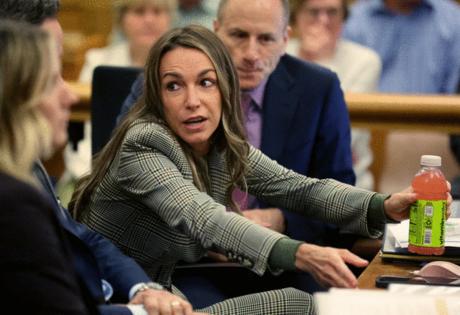Judge denies defense's demand for mistrial in Karen Read case
Published in News & Features
DEDHAM, Mass. — Drama unfolded in the Karen Read retrial when her defense team called for a mistrial after they say the prosecutor improperly introduced evidence during cross-examination. The judge denied the motion.
“What has just happened is antithetical, abhorrent to a fair trial,” defense attorney Robert Allessi said outside the jury’s presence. “The only remedy — the only remedy — is a mistrial with prejudice.”
The dramatic moment came the same day that a police officer testified that there was significantly less damage to Read’s taillight when he encountered it at her parent’s house in Dighton than when it was photographed in police custody.
It’s important testimony for the defense because it served to undercut the prosecution’s theory that Read struck victim John O’Keefe with her Lexus LX570 SUV sometime around 12:30 a.m. on Jan. 29, 2022. The prosecution has made much of the damage to the taillight because if it was damaged upon impact with O’Keefe it proves their theory.
Read, 45, of Mansfield, faces charges of second-degree murder, manslaughter while operating a motor vehicle under the influence, and leaving the scene of a collision causing death.
The mistrial motion
Alessi’s call for a mistrial came in response to special prosecutor Hank Brennan cross-examination of a defense expert, Dr. Marie Russell, who testified she believes wounds to the victim’s arms were caused by a dog bite and not a vehicle strike.
Russell was primarily under cross-examination on Tuesday and had provided direct testimony on Monday.
Brennan asked Russell, a trained emergency doctor and pathologist who has published papers on dog bite wounds, if she was aware that there was no dog DNA found on the hooded sweatshirt O’Keefe was wearing at the time of his death.
Alessi objected and called for a sidebar, which is a private discussion between attorneys and the judge, on the matter. When it went long, the judge dismissed the jury for their morning break and the attorneys took their arguments to open court.
Alessi said that Brennan “intentionally” introduced the evidence improperly after having purposefully not used it during his own presentation of the case, which ended last week. Because of this, he said, the defense had been “meticulous about not mentioning DNA in any fashion directly or indirectly.”
Brennan countered that asking about the absence of DNA “is not only proper and permissible, it’s essential.”
“The commonwealth is entitled on cross-examination to explore theories and facades that the defense creates if there is actual evidence that undermines or contradicts the representations that they are trying to portray to this jury,” Brennan said.
He added that he didn’t intend to “try to disprove all of their various theories” during his presentation but would use evidence to rebut the defense’s “unsubstantiated theories” during cross-examination, as he did here.
Judge Cannone took some 30 minutes to consider the motion and allowed the line of questioning. However, she will not allow Brennan to introduce as evidence another doctor’s report that disagrees with Russell’s assessment.
Brennan’s other cross-examination questioned whether Russell had adequately considered other circumstances and information about O’Keefe’s wounds to come to her conclusion to a reasonable degree.
In particular, he pointed out a paper by another doctor which had concluded that the injuries are “highly unlikely to be the result of an animal bite attack.”
She said she had read the report but, “I don’t know if he’s ever had any experience with dog bite examinations so I had to consider that and weigh it.”
The taillight
Dighton Police Sgt. Nicholas Barros testified that he was called by the Massachusetts State Police and asked to go to Read’s parent’s house in Dighton and secure the scene so the troopers could interview Read and tow the suspect vehicle. He said it’s common for other police agencies on a case to involve the local police when working in their jurisdiction.
The brunt of Barros’ testimony is that he observed only a small section of the SUV’s right taillight to be missing when he arrived at around 3:15 the afternoon of O’Keefe’s death. He indicated the size with his fingers but agreed with defense attorney Alan Jackson’s suggestion that it was some six inches long, or about the size of a dollar bill.
Jackson played a video of Read’s SUV being put onto the tow truck that appeared to show what Barros described. Jackson also put up a photo of the SUV once it was in the Canton Police Department garage later, which showed the taillight in a different state.
Jackson asked if this is how Barros saw the taillight in Dighton.
“Absolutely not,” Barros said. “That taillight is completely smashed out.”
Barros also testified in the first trial last year, but that time was called by the prosecution.
In cross-examination, Brennan highlighted that Barros described the damage to the taillight in his report from that day with only one line and no details, as police training instructs that officers are supposed to provide detail on essential elements.
Brennan also confirmed that Barros had met with Jackson at his hotel before this trial, in which they discussed the taillight discrepancy.
Brennan asked if Barros could have been unduly influenced by media coverage and asked if he had been exposed to trial coverage.
“With all due respect, I don’t live under a rock,” Barros said, saying coverage of this case has been unavoidable.
_____
©2025 MediaNews Group, Inc. Visit at bostonherald.com. Distributed by Tribune Content Agency, LLC.







Comments